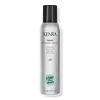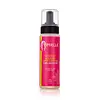What's inside
What's inside
 Benefits
Benefits

 Concerns
Concerns

 Ingredients Side-by-side
Ingredients Side-by-side

Water
Skin ConditioningPvp
Emulsion StabilisingCetearyl Alcohol
EmollientGlycerin
HumectantPetrolatum
EmollientNitrogen
Paraffinum Liquidum
EmollientBehentrimonium Chloride
PreservativeParfum
MaskingCetrimonium Chloride
AntimicrobialPolyquaternium-11
Panthenol
Skin ConditioningAmodimethicone
Laureth-9
EmulsifyingC11-15 Pareth-7
EmulsifyingDiazolidinyl Urea
PreservativeIsopropyl Alcohol
SolventTrideceth-12
EmulsifyingPhenoxyethanol
PreservativeAcetic Acid
BufferingDisodium EDTA
Iodopropynyl Butylcarbamate
PreservativeEthylhexylglycerin
Skin ConditioningLinalool
PerfumingCoumarin
PerfumingEugenol
PerfumingBenzyl Salicylate
PerfumingHexyl Cinnamal
PerfumingWater, Pvp, Cetearyl Alcohol, Glycerin, Petrolatum, Nitrogen, Paraffinum Liquidum, Behentrimonium Chloride, Parfum, Cetrimonium Chloride, Polyquaternium-11, Panthenol, Amodimethicone, Laureth-9, C11-15 Pareth-7, Diazolidinyl Urea, Isopropyl Alcohol, Trideceth-12, Phenoxyethanol, Acetic Acid, Disodium EDTA, Iodopropynyl Butylcarbamate, Ethylhexylglycerin, Linalool, Coumarin, Eugenol, Benzyl Salicylate, Hexyl Cinnamal
Water
Skin ConditioningPolyquaternium-11
Cocamidopropyl Betaine
CleansingPhenoxyethanol
PreservativePanthenol
Skin ConditioningOleth-20
CleansingPEG-75 Lanolin
EmollientCetrimonium Chloride
AntimicrobialQuaternium-80
Parfum
MaskingHydrolyzed Wheat Protein
Skin ConditioningOrbignya Oleifera Seed Oil
EmollientMauritia Flexuosa Fruit Oil
Skin ConditioningCopaifera Officinalis Resin
MaskingAstrocaryum Murumuru Seed Butter
EmollientBenzoic Acid
MaskingEthylhexylglycerin
Skin ConditioningGlycereth-2 Cocoate
EmulsifyingLimonene
PerfumingLinalool
PerfumingHexyl Cinnamal
PerfumingGeraniol
PerfumingWater, Polyquaternium-11, Cocamidopropyl Betaine, Phenoxyethanol, Panthenol, Oleth-20, PEG-75 Lanolin, Cetrimonium Chloride, Quaternium-80, Parfum, Hydrolyzed Wheat Protein, Orbignya Oleifera Seed Oil, Mauritia Flexuosa Fruit Oil, Copaifera Officinalis Resin, Astrocaryum Murumuru Seed Butter, Benzoic Acid, Ethylhexylglycerin, Glycereth-2 Cocoate, Limonene, Linalool, Hexyl Cinnamal, Geraniol
Ingredients Explained
These ingredients are found in both products.
Ingredients higher up in an ingredient list are typically present in a larger amount.
This ingredient is a preservative, antimicrobial, and emulsifier. It is often used in cosmetics for its ability to cleanse, condition, and reduce static.
Cetrimonium chloride is a quaternary ammonium salt, meaning it has a water-soluble structure.
Ethylhexylglycerin (we can't pronounce this either) is commonly used as a preservative and skin softener. It is derived from glyceryl.
You might see Ethylhexylglycerin often paired with other preservatives such as phenoxyethanol. Ethylhexylglycerin has been found to increase the effectiveness of these other preservatives.
Hexyl Cinnamal is a fragrance ingredient with a similar scent to jasmine. It can be naturally found in chamomile essential oil.
This ingredient is a known EU allergen and may sensitize the skin. The EU requires this ingredient to be listed separately on an ingredients list.
Hexyl Cinnamal is not water soluble but is soluble in oils.
Learn more about Hexyl CinnamalLinalool is a fragrance and helps add scent to products. It's derived from common plants such as cinnamon, mint, citrus, and lavender.
Like Limonene, this ingredient oxidizes when exposed to air. Oxidized linalool can cause allergies and skin sensitivity.
This ingredient has a scent that is floral, spicy tropical, and citrus-like.
Learn more about LinaloolPanthenol is a common ingredient that helps hydrate and soothe the skin. It is found naturally in our skin and hair.
There are two forms of panthenol: D and L.
D-panthenol is also known as dexpanthenol. Most cosmetics use dexpanthenol or a mixture of D and L-panthenol.
Panthenol is famous due to its ability to go deeper into the skin's layers. Using this ingredient has numerous pros (and no cons):
Like hyaluronic acid, panthenol is a humectant. Humectants are able to bind and hold large amounts of water to keep skin hydrated.
This ingredient works well for wound healing. It works by increasing tissue in the wound and helps close open wounds.
Once oxidized, panthenol converts to pantothenic acid. Panthothenic acid is found in all living cells.
This ingredient is also referred to as pro-vitamin B5.
Learn more about PanthenolParfum is a catch-all term for an ingredient or more that is used to give a scent to products.
Also called "fragrance", this ingredient can be a blend of hundreds of chemicals or plant oils. This means every product with "fragrance" or "parfum" in the ingredients list is a different mixture.
For instance, Habanolide is a proprietary trade name for a specific aroma chemical. When used as a fragrance ingredient in cosmetics, most aroma chemicals fall under the broad labeling category of “FRAGRANCE” or “PARFUM” according to EU and US regulations.
The term 'parfum' or 'fragrance' is not regulated in many countries. In many cases, it is up to the brand to define this term.
For instance, many brands choose to label themselves as "fragrance-free" because they are not using synthetic fragrances. However, their products may still contain ingredients such as essential oils that are considered a fragrance by INCI standards.
One example is Calendula flower extract. Calendula is an essential oil that still imparts a scent or 'fragrance'.
Depending on the blend, the ingredients in the mixture can cause allergies and sensitivities on the skin. Some ingredients that are known EU allergens include linalool and citronellol.
Parfum can also be used to mask or cover an unpleasant scent.
The bottom line is: not all fragrances/parfum/ingredients are created equally. If you are worried about fragrances, we recommend taking a closer look at an ingredient. And of course, we always recommend speaking with a professional.
Learn more about ParfumPhenoxyethanol is a preservative that has germicide, antimicrobial, and aromatic properties. Studies show that phenoxyethanol can prevent microbial growth. By itself, it has a scent that is similar to that of a rose.
It's often used in formulations along with Caprylyl Glycol to preserve the shelf life of products.
We don't have a description for Polyquaternium-11 yet.
Water. It's the most common cosmetic ingredient of all. You'll usually see it at the top of ingredient lists, meaning that it makes up the largest part of the product.
So why is it so popular? Water most often acts as a solvent - this means that it helps dissolve other ingredients into the formulation.
You'll also recognize water as that liquid we all need to stay alive. If you see this, drink a glass of water. Stay hydrated!
Learn more about Water